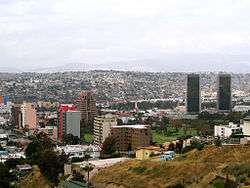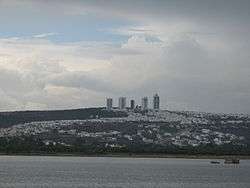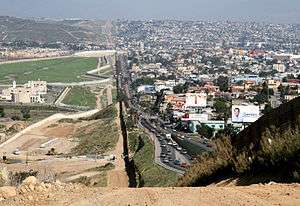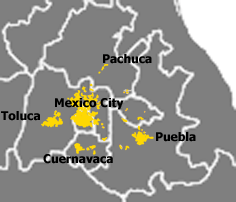Metropolitan areas of Mexico

Metropolitan areas in Mexico have been traditionally defined as the group of municipalities that heavily interact with each other, usually around a core city.[1]
Methodology
In 2004, a joint effort between CONAPO, INEGI and the Ministry of Social Development (SEDESOL) agreed to define metropolitan areas as one of the following:[1]
- the group of two or more municipalities, in which a city with a population of at least 50,000 is located whose urban area extends over the limit of the municipality that originally contained the core city incorporating either physically or, under its area of direct influence, other adjacent predominantly urban municipalities, all of which either have a high degree of social and economic integration or are relevant for urban politics and administration; or
- a single municipality, in which a city of a population of at least one million is located and fully contained (that is, it does not transcend the limits of a single municipality); or
- a city with a population of at least 250,000 that forms a conurbation with other cities in the United States.
Northwestern and southeastern states are divided into a small number of large municipalities whereas central states are divided into a large number of smaller municipalities. As such, metropolitan areas in the northwest usually do not extend over more than one municipality (and figures usually report population for the entire municipality) whereas metropolitan areas in the center extend over many municipalities.
A few metropolitan areas extend beyond the limits of one state: Greater Mexico City (Federal District, Mexico and Hidalgo), Puebla-Tlaxcala (Puebla and Tlaxcala, but excludes the city of Tlaxcala), Comarca Lagunera (Coahuila and Durango), and Tampico (Tamaulipas and Veracruz).
List of metropolitan areas in Mexico by population







There are a total of fifty-six metropolitan areas of Mexico as defined by the following government bodies:
- The National Institute of Statistics and Geography (INEGI).
- The Secretariat of Social Development (SEDESOL).
- The National Population Council (CONAPO).
| Rank | Metropolitan Area | Federative Entity | 2010 Pop. | 2000 Pop. | Change |
|---|---|---|---|---|---|
| 1 | Greater Mexico City | DF, Mexico, Hidalgo | 20,137,152 | 18,396,677 | +9.46% |
| 2 | Greater Guadalajara | Jalisco | 4,434,252 | 3,699,136 | +19.87% |
| 3 | Greater Monterrey | Nuevo León | 4,106,054 | 3,374,361 | +21.68% |
| 4 | Greater Puebla | Puebla, Tlaxcala | 2,728,790 | 2,220,533 | +22.89% |
| 5 | Greater Toluca | Mexico | 1,936,126 | 1,451,801 | +33.36% |
| 6 | Greater Tijuana | Baja California | 1,751,302 | 1,352,035 | +29.53% |
| 7 | Greater León | Guanajuato | 1,609,717 | 1,269,179 | +26.83% |
| 8 | Greater Juárez | Chihuahua | 1,495,094 | 1,218,817 | +22.67% |
| 9 | Greater Torreón | Coahuila, Durango | 1,275,993 | 1,007,291 | +26.68% |
| 10 | Greater Querétaro | Querétaro | 1,097,028 | 816,481 | +34.36% |
| 11 | Greater San Luis Potosí | San Luis Potosí | 1,040,822 | 850,828 | +22.33% |
| 12 | Greater Mérida | Yucatán | 973,046 | 803,920 | +21.04% |
| 13 | Greater Mexicali | Baja California | 936,145 | 764,602 | +22.44% |
| 14 | Greater Aguascalientes | Aguascalientes | 932,298 | 707,516 | +31.77% |
| 15 | Greater Cuernavaca | Morelos | 875,598 | 738,326 | +18.59% |
| 16 | Greater Acapulco | Guerrero | 863,438 | 791,558 | +9.08% |
| 17 | Greater Tampico | Tamaulipas, Veracruz | 858,620 | 746,417 | +15.03% |
| 18 | Greater Chihuahua | Chihuahua | 851,971 | 696,495 | +22.32% |
| 19 | Greater Saltillo | Coahuila | 823,098 | 637,273 | +29.16% |
| 20 | Greater Morelia | Michoacán | 806,822 | 659,940 | +22.26% |
| 21 | Greater Veracruz | Veracruz | 801,122 | 642,680 | +24.65% |
| 22 | Greater Villahermosa | Tabasco | 755,416 | 600,580 | +25.78% |
| 23 | Reynosa–Greater Río Bravo | Tamaulipas | 725,793 | 524,692 | +38.33% |
| 24 | Greater Cancún | Quintana Roo | 676,238 | 431,128 | +56.85% |
| 25 | Greater Xalapa | Veracruz | 666,268 | 510,410 | +30.54% |
| 26 | Greater Tuxtla | Chiapas | 640,881 | 494,763 | +29.53% |
| 27 | Greater Oaxaca | Oaxaca | 593,522 | 460,350 | +28.93% |
| 28 | Greater Poza Rica | Veracruz | 513,308 | 443,419 | +15.76% |
| 29 | Greater Pachuca | Hidalgo | 512,180 | 375,022 | +36.57% |
| 30 | Tlaxcala–Apizaco | Tlaxcala | 499,504 | 408,401 | +22.31% |
| 31 | Greater Matamoros | Tamaulipas | 493,308 | 418,141 | +17.98% |
| 32 | Greater Cuautla | Morelos | 434,153 | 358,405 | +21.13% |
| 33 | Greater Tepic | Nayarit | 429,161 | 342,840 | +25.18% |
| 34 | Greater Orizaba | Veracruz | 410,372 | 367,021 | +11.81% |
| 35 | Greater Nuevo Laredo | Tamaulipas | 384,018 | 310,915 | +23.51% |
| 36 | Greater Puerto Vallarta | Jalisco, Nayarit | 379,934 | 244,536 | +55.37% |
| 37 | Greater Minatitlán | Veracruz | 356,020 | 323,389 | +10.09% |
| 38 | Greater Coatzacoalcos | Veracruz | 347,223 | 307,724 | +12.84% |
| 39 | Colima–Villa de Álvarez | Colima | 333,977 | 210,766 | +58.46% |
| 40 | Monclova–Frontera | Coahuila | 317,314 | 282,853 | +12.18% |
| 41 | Greater Córdoba | Veracruz | 315,996 | 276,553 | +14.26% |
| 42 | Zacatecas–Guadalupe | Zacatecas | 298,143 | 232,965 | +27.98% |
| 43 | Greater Tehuacán | Puebla | 296,894 | 240,507 | +23.45% |
| 44 | La Piedad–Pénjamo | Michoacán, Guanajuato | 249,854 | 229,372 | +8.93% |
| 45 | Zamora–Jacona | Michoacán | 249,805 | 216,048 | +15.62% |
| 46 | Greater Tulancingo | Hidalgo | 239,575 | 193,638 | +23.72% |
| 47 | Greater Tula | Hidalgo | 205,848 | 169,901 | +21.16% |
| 48 | Greater Guaymas | Sonora | 203,442 | 180,316 | +12.83% |
| 49 | Greater San Francisco del Rincón | Guanajuato | 182,330 | 145,017 | +25.73% |
| 50 | Greater Piedras Negras | Coahuila | 180,701 | 151,149 | +19.55% |
| 51 | Greater Tehuantepec | Oaxaca | 161,343 | 145,567 | +10.84% |
| 52 | Greater Tecomán | Colima | 141,465 | 127,863 | +10.64% |
| 53 | Greater Ocotlán | Jalisco | 141,365 | 125,027 | +13.07% |
| 54 | Greater Rioverde | San Luis Potosí | 135,423 | 128,935 | +5.03% |
| 55 | Greater Acayucan | Veracruz | 112,999 | 102,992 | +9.72% |
| 56 | Moroleón–Uriangato | Guanajuato | 108,648 | 100,063 | +8.58% |
Transnational conurbations

The United States shares a 2,000-mile (3,000 km) border with Mexico. The 2,000 miles is the most frequently crossed international border in the world, with about 250 million legal crossings every year.[2] The distribution of population and urban population in Mexico has been changed significantly by the economic interaction between settlements in its north and the United States (U.S.). The increasing population concentration in the north of Mexico is strongly associated with the development of the maquila industries there and the eventual economic effects of North American Free Trade Agreement (NAFTA).[4]
Metropolitan areas located at the border with the U.S. form transnational conurbations with deep economic and demographic interaction. For example, the San Diego – Tijuana metropolitan area consists of San Diego County in the U.S. and the municipalities of Tijuana, Playas de Rosarito, and Tecate in Mexico. The total population of the region has been estimated to be just over 5 million in 2009, making it by far the largest bi-national metropolitan area shared between the U.S. and Mexico.[5] The National Population Council (CONAPO) recognizes the existence of such metropolitan areas and defines them as the municipalities that contain a city of at least 200,000 inhabitants which share processes of conurbation with cities of the U.S.[1]
| Rank | Metropolitan Area | Mexican State | American State | Population |
|---|---|---|---|---|
| 1 | Tijuana - San Diego | Baja California | California | 5,009,170[5] |
| 2 | El Paso - Juarez | Chihuahua | Texas | 2,345,182[5] |
| 3 | Reynosa - McAllen | Tamaulipas | Texas | 1,500,000[5] |
| 4 | Matamoros - Brownsville | Tamaulipas | Texas | 1,136,995[5] |
| 5 | Mexicali - Calexico | Baja California | California | 956,223[5] |
| 6 | Nuevo Laredo - Laredo | Tamaulipas | Texas | 747,494[5] |
| 7 | Nogales - Nogales | Sonora | Arizona | 234,809[nb 1] |
| 8 | Piedras Negras - Eagle Pass | Coahuila | Texas | 230,205[nb 2] |
| 9 | San Luis Río Colorado - San Luis | Sonora | Arizona | 188,152[nb 3] |
| 10 | Ciudad Acuña - Del Río | Coahuila | Texas | 183,750[nb 4] |
Mexico City megalopolis

A megalopolis is defined as a long chain of continuous metropolitan areas, or territories that are relatively integrated amongst each other, a clear example of which is the Northeast Megalopolis in the United States. In 1996, the Programa General de Desarollo Urbano del Distrito Federal first proposed this concept to refer to the Mexico City megalopolis, or "Megalopolis of central Mexico", which was later expanded by PROAIRE, a metropolitan commission on the environment.[6]
A megalopolis, is known in Spanish as a corona regional de ciudades ("regional ring of cities"). The Megalopolis of central Mexico was defined to be integrated by the metropolitan areas of Mexico City, Puebla, Cuernavaca, Toluca and Pachuca, which may also conform complex subregional rings themselves (i.e. Greater Puebla conforming a regional ring with Atlixco, San Martín Texmelucan, Tlaxcala and Apizaco).
The megalopolis consists of 173 municipalities (91 of the state of Mexico, 29 of the state of Puebla, 37 of the state of Tlaxcala, 16 of Morelos and 16 of Hidalgo) and the 16 boroughs of the Federal District,[6] with an approximate total population of almost 27 million people.
See also
- List of metropolitan areas by population
- List of metropolitan areas in the Americas by population
- List of cities in Mexico
- Demographics of Mexico
Notes
- ↑ Sum of legal residents of Nogales, Sonora (213,976) and Nogales, Arizona (20,833).
- ↑ Sum of legal residents of Eagle Pass Metropolitan Area's population (48,401) and Piedras Negras, Coahuila (154,360).
- ↑ Sum of legal residents of San Luis Río Colorado, Sonora (164,342) and San Luis, Arizona (23,810).
- ↑ Sum of legal residents of Ciudad Acuña, Coahuila (135,605) and Del Rio, Texas (46,682).
References
- 1 2 3 s/espanol/metodologias/otras/zonas_met.pdf CONAPO Áreas Metropolitanas
- 1 2 David M. Bridgeland, Ron Zahavi. Business Modeling: A Practical Guide to Realizing Business Value. Morgan Kaufmann, 2008. p. 134. ISBN 0-12-374151-3.
- ↑ "Borders and Law Enforcement". U.S. Embassy Mexico. Retrieved 8 December 2009.
- ↑ Michael Pacione. Urban geography: a global perspective. Routledge, 2005. p. 105. ISBN 0-415-34305-4.
- 1 2 3 4 5 6 7 "Metropolitan areas in the Americas". World Gazetteer. Archived from the original on 2007-10-01. Retrieved 8 December 2009.
- 1 2 Área metropolitana del Valle de México PROAIRE
External links
- National Population Council (CONAPO) — official website. (Spanish)
- National Institute of Statistics and Geography (INEGI) — official website. (Spanish)
